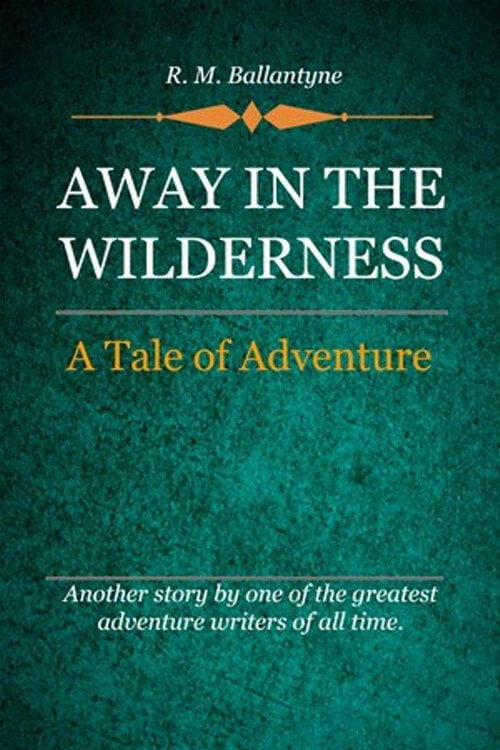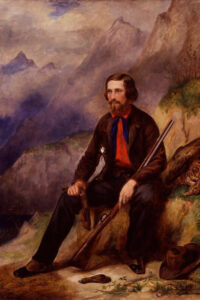
Away in the Wilderness, Red Indians and Fur Traders of North America
On a beautiful summer evening, not many years ago, a man was seen ascending the side of a little mound or hillock, on the top of which he lingered to gaze upon the wild scenery that lay stretched out before him.
The man wore the leathern coat and leggings of a North American hunter, or trapper, or backwoodsman; and well did he deserve all these titles, for Jasper Derry was known to his friends as the best hunter, the most successful trapper, and the boldest man in the backwoods.
Jasper was big and strong as well as bold, but he was not a bully. Men of true courage are in general peacefully disposed. Jasper could fight like a lion when there was occasion to do so, but he was gentle and grave, and quiet by nature. He was also extremely good-humored; had a low soft voice, and, both in mind and body, seemed to delight in a state of repose.
We have said that his coat was made of leather; the moccasins or Indian shoes on his feet were made of the same material. When Jasper first put them on they were soft like a glove of chamois leather, and bright yellow; but hard service had turned them into a dirty brown, which looked more business-like. The sun had burned his face and hands to as deep a brown as his coat. On his head, he wore a little round cap, which he had made with his own hands, after having caught the black fox that supplied the fur, in one of his traps. A colored worsted belt bound his coat around his waist, and beneath the coat, he wore a scarlet flannel shirt. A long knife and a small hatchet were stuck in the belt at his back, and in front hung a small cloth bag, which was so thickly ornamented with beads of many colors, that little of the cloth could be seen.
This last was a fire-bag—so called because it contained the flint, steel, and tinder required for making a fire. It also contained Jasper’s pipe and tobacco—for he smoked, as a matter of course. Men smoke everywhere—more’s the pity—and Jasper followed the example of those around him. Smoking was almost his only fault. He was a tremendous smoker. Often, when out of tobacco, he had smoked tea. Frequently he had tried bark and dried leaves; and once, when hard pressed, he had smoked oakum. He would rather have gone without his supper than without his pipe! A powder horn and shot pouch were slung over his shoulders by two cross belts, and he carried a long single-barrelled gun.
I have been thus particular in describing Jasper Derry, because he is our hero, and he is worth describing, being a fine, hearty, handsome fellow, who cared as little for a wild Indian or a grizzly bear as he did for a butterfly, and who was one of the best of companions, as he was one of the best of hunters, in the wilderness.
Having gained the top of the hillock, Jasper placed the butt of his long gun on the ground, and, crossing his hands over the muzzle, stood there for some time so motionless, that he might have been mistaken for a statue. A magnificent country was spread out before him. Just in front lay a clear lake of about a mile in extent, and the evening was so still that every tree, stone, and bush on its margin, was reflected as in a mirror.
Read or download Book
Robert Michael Ballantyne
Robert Michael Ballantyne (24 April 1825 – 8 February 1894) was a Scottish author of juvenile fiction, who wrote more than a hundred books.
Biography.
He was also an accomplished artist: he exhibited some of his watercolors at the Royal Scottish Academy. In 1847 Ballantyne returned to Scotland to discover that his father had died. He published his first book the following year, Hudson’s Bay: or, Life in the Wilds of North America, and for some time was employed by the publisher Messrs Constable. In 1856, he gave up business to focus on his literary career and began the series of adventure stories for the young with which his name is popularly associated. The Young Fur-Traders (1856), The Coral Island (1857), The World of Ice (1859), Ungava: a Tale of Eskimo Land (1857), The Dog Crusoe (1860), The Lighthouse (1865), Fighting the Whales (1866), Deep Down (1868), The Pirate City (1874), Erling the Bold (1869), The Settler and the Savage (1877), and more than 100 other books followed in regular succession, his rule being to write as far as possible from personal knowledge of the scenes he described.
The Gorilla Hunters. A Tale of the Wilds of Africa (1861) shares three characters with The Coral Island: Jack Martin, Ralph Rover, and Peterkin Gay. Here Ballantyne relied factually on Paul du Chaillu’s Exploration in Equatorial Guinea, which had appeared early in the same year. The Coral Island is the most popular of the Ballantyne novels still read and remembered today, but because of one mistake he made in that book, in which he gave an incorrect thickness of coconut shells, he subsequently attempted to gain first-hand knowledge of his subject matter. For instance, he spent some time living with the lighthouse keepers at the Bell Rock before writing The Lighthouse, and while researching for Deep Down he spent time with the tin miners of Cornwall. In 1866 Ballantyne married Jane Grant (c. 1845 – c. 1924), with whom he had three sons and three daughters.






